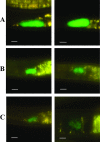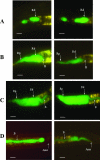New insights into the colonization and release processes of Xenorhabdus nematophila and the morphology and ultrastructure of the bacterial receptacle of its nematode host, Steinernema carpocapsae
- PMID: 17526783
- PMCID: PMC1951000
- DOI: 10.1128/AEM.02947-06
New insights into the colonization and release processes of Xenorhabdus nematophila and the morphology and ultrastructure of the bacterial receptacle of its nematode host, Steinernema carpocapsae
Abstract
We present results from epifluorescence, differential interference contrast, and transmission electron microscopy showing that Xenorhabdus nematophila colonizes a receptacle in the anterior intestine of the infective juvenile (IJ) stage of Steinernema carpocapsae. This region is connected to the esophagus at the esophagointestinal junction. The process by which X. nematophila leaves this bacterial receptacle had not been analyzed previously. In this study we monitored the movement of green fluorescent protein-labeled bacteria during the release process. Our observations revealed that Xenorhabdus colonizes the distal region of the receptacle and that exposure to insect hemolymph stimulated forward movement of the bacteria to the esophagointestinal junction. Continued exposure to hemolymph caused a narrow passage in the distal receptacle to widen, allowing movement of Xenorhabdus down the intestine and out the anus. Efficient release of both the wild type and a nonmotile strain was evident in most of the IJs incubated in hemolymph, whereas only a few IJs incubated in nutrient-rich broth released bacterial cells. Incubation of IJs in hemolymph treated with agents that induce nematode paralysis dramatically inhibited the release process. These results suggest that bacterial motility is not required for movement out of the distal region of the receptacle and that hemolymph-induced esophageal pumping provides a force for the release of X. nematophila out of the receptacle and into the intestinal lumen.
Figures







References
-
- Akhurst, R. J. 1982. Antibiotic activity of Xenorhabdus spp., bacteria symbiotically associated with insect pathogenic nematodes of the families Heterorhabditidae and Steinernematidae. J. Gen. Microbiol. 128:3061-3065. - PubMed
-
- Akhurst, R. J. 1983. Neoaplectana species: specificity of association with bacteria of the genus Xenorhabdus. Exp. Parasitol. 55:258-263. - PubMed
-
- Akhurst, R. J., and N. E. Boemare. 1990. Biology and taxonomy of Xenorhabdus, p. 75-90. In R. Gaugler and H. K. Kaya (ed.), Entomopathogenic nematodes in biological control. CRC Press, Boca Raton, FL.
-
- Bird, A. F., and R. J. Akhurst. 1983. The nature of the intestinal vesicle in nematodes of the family Steinernematidae. Int. J. Parasitol. 16:511-518.
Publication types
MeSH terms
LinkOut - more resources
Full Text Sources
Molecular Biology Databases

